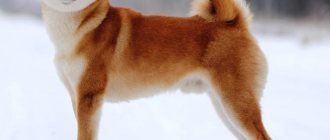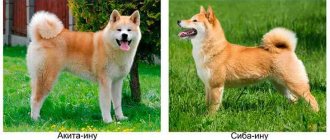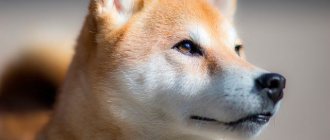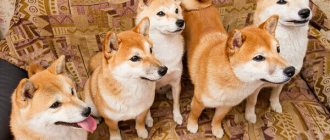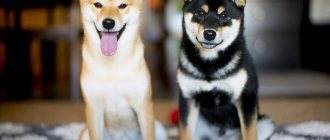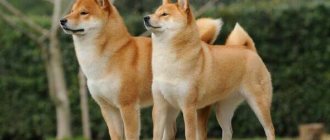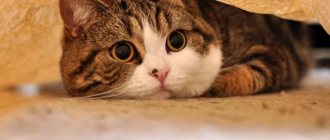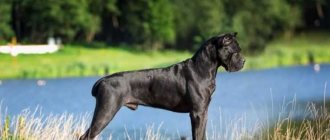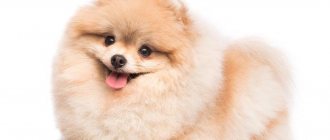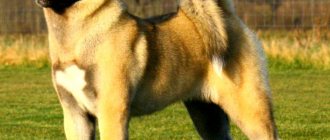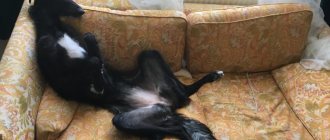| Origin: | Japan |
| Usage: | hunting dog, companion |
| Color: | red, black and tan, sesame |
| Dimensions: | height 37-40 cm +/- 1.5 cm, weight 8-10 kg |
| Lifespan: | 13-15 years old |
Shiba Inu (or Shiba) is an ancient Japanese breed. This is an unusually charming and charismatic dog that has become popular in many countries around the world. But an animal requires a special approach - not everyone can find a common language with a pet. The article provides basic information about the breed - origin, appearance, temperament and maintenance characteristics.
Breed standard
The Shiba Inu is a miniature but strong pet with an athletic build. The animal's movements are energetic, fast and beautiful - nothing should hinder them. Many dog breeders call the breed mini Akita Inu because of its external resemblance to its taller relatives.
The Shiba Inu breed standard provides for the ideal physical parameters of animals:
- height at the withers for males – 40 cm, for females – 37 cm. Indicators may be less or more than indicated by 1.5 cm;
- The weight of an adult Shiba Inu is proportional to its height. Usually it ranges between 8-10 kg.
Official description of the breed (FCI standard No. 257):
| Become | Breed characteristics |
| Head | Wide with a flat forehead, proportional to the body. The stop is clearly visible. |
| Muzzle | Wedge-shaped, sharpening as it approaches the nose. Because of this, the Shiba Inu looks a little like a fox. |
| Nose | Black color of the lobe is preferable. |
| Jaws | Closed in a scissor bite. |
| Eyes | Quite small, shaped like a triangle. The color of the iris is dark brown. The Shiba Inu has a cunning and playful look with a slight squint, which can be seen even in the photograph. |
| Ears | Medium size, rather small, erect, triangular. The tips are tilted slightly forward. |
| Torso | Stretched format - the ratio of height to length is 10 to 11. The chest is voluminous, the stomach is tucked. |
| Tail | Thick, fluffy, sits high. It is twisted into a ring or crescent-shaped. |
| Limbs | Strong, muscular, set parallel. The paws are compact and curved. Black claws are desirable |
In Japan, Shiba Inus are assessed according to slightly different criteria - the country has the Nippo standard. It does not contradict, but only complements the FCI standard. According to this document, a mini Akita Inu should be harmonious and athletic, with strong bones and a large head. The emphasis is on gender differences - females are always more feminine and fragile than males.
The Shiba Inu has a hard, dense coat. The outer hair of animals is slightly bristling due to the fluffy and thick undercoat. The fur on the tail is slightly longer.
The most common Shiba Inus are red. However, other colors are also allowed:
- black and tan;
- sesame – the pet’s body is colored black and white in approximately equal proportions;
- black sesame – black suit prevails over white;
- red sesame – red is the dominant color, but mixed with black.
In mini Akita dogs of any color, lighter hair is found on the lower part of the body - neck, chest, belly, and the inside of the limbs. White and cream colors go beyond the RKF standard - such animals are not allowed for breeding.
Disqualifying faults of a Shiba Inu:
- tendency towards aggression or cowardice;
- not erect ears;
- drooping or stubby tail.
A Shiba Inu dog that has obvious defects in appearance or behavioral anomalies is also subject to disqualification.
Puppy development
Shiba Inu puppies are growing rapidly. In order to identify the disease in a timely manner, it is necessary to study the generally accepted norms of child development. Small deviations are acceptable - a Shiba Inu may gain weight a little slower or faster. However, a significant discrepancy should raise red flags. Perhaps the animal does not meet the standard or the pet exhibits some pathology.
The table below displays the growth dynamics of Shiba Inu puppies by month:
| Age (month) | Dimensions |
| Newborn | They weigh 300-400 g, gaining up to several tens of grams per day. |
| 2 | Weight reaches 2.7-3 kg. Babies are fed 6 times a day at regular intervals. |
| 3 | Puppies are transferred to 5 meals a day. By this time they should weigh about 3.5 kg. |
| 5 | The pet is actively developing and learning about the world around it. The number of feedings is reduced to 4. Weight is about 4 kg. |
| 9 | The growth of the Shiba Inu slows down, the pet is practically no different from an adult dog. From this time on, the animal is fed twice a day, but during active physical work it is permissible to give food 3 times. |
If your Shiba Inu looks harmonious, is active and moves freely, a slight discrepancy with the norm should not be a cause for concern.
A companion from ancient times to the present day
The first ancestors of modern Shiba Inu appeared 2500 years ago in Japan and helped ancient people in hunting. The hunting instincts are alive in these dogs and to this day, it will not be difficult for them to catch a mouse or a bird.
After repeated crossings with species imported from Central Asia, six breeds of all sizes appeared, including the short Shiba. These dogs, living in different regions, differed in appearance and behavior.
It is generally accepted that the Shiba Inu is a descendant of dogs from the regions of Shin-shu, San-in, and Mino.
It should be noted that previously the characteristics of the Shiba Inu breed were different: the coat color was observed from black and white to red-red, the dogs could have hanging ears and a tail.
This variation in characteristics occurred due to constant crossing with Chow Chows and Setters. Selection work began only in 1920, and specialists developed the breed standard only in 1934.
Character
The Shiba Inu has a cheerful, perky, friendly, but cunning and slightly capricious character. For a pet to reveal its positive qualities, it needs a competent leader with a firm hand.
Representatives of the breed are very active and need constant movement and entertainment. The Shiba Inu will not be able to play the role of a sofa pet - it needs to realize the potential inherent in nature. Moreover, physical activity should alternate with intellectual activity.
The Shiba dog is smart, but problems often arise during training - a special approach is needed to the pet. Representatives of the breed are very independent. Most often, adolescent animals demonstrate disobedience. During puberty, they often test their owners' strength. If you give up the slack, the mini Akita Inu will take the position of leader and begin to dominate all family members.
To achieve obedience, the owner should build a partnership with the pet. The Mini Akita does not believe that it owes anything to humans.
Until the dog wants, nothing will force him to perform the required action. Therefore, the animal needs to be shown that its interests are also taken into account, and its opinions are listened to.
History of the origin of the Shiba Inu
The oldest remains of dogs on the islands of Japan are about 9 thousand years old. Some researchers believe that there were already Shiba Inus among them, but others insist that they appeared only in the 3rd century BC, with the second wave of settlers. It is even more likely that they were descendants of both the dogs of the earliest settlers and those who arrived in the second wave.
In any case, Shiba Inus have been around for a very long time. However, it must be borne in mind that this breed as such did not exist until the beginning of the 20th century. Many different variations existed in the country at the same time; they could even be considered different breeds. They were all called Shiba Inu, that is, simply, “little dog.”
Then they were kept for hunting and protecting the house from rodents - in this they sometimes replaced cats, which is why they resemble them in their independence of character. For a long time, Japan remained isolated from the outside world, which is why local dog breeds lived only on the islands.
Interesting fact: In the middle of the 19th century, isolation ended and they gradually began to spread outside the country. The reverse process was more active; dogs were brought to Japan from abroad. When crossed with them, it was possible to get a stronger and more resilient dog.
As a result, by the beginning of the 20th century, the breed had practically disappeared in cities and was preserved only in remote corners. Then Japanese breeders set about rescuing her. A breed standard was developed, dogs whose exterior best matched it were found, and breeding began.
But the restoration process was interrupted by the war. After it, most of the Shiba Inu variations disappeared, out of several dozen, only three remained: all modern ones descend from them. Now the Shiba Inu is the most popular breed in Japan, and is kept in both cities and villages throughout the country. It has spread widely in other countries. Although the Shiba Inu is not one of the most common breeds, it can also be found in Russia.
Socialization
Shiba Inu puppies are actively socialized from 2.5 to 7 months. At this time, the pet should receive as many new experiences as possible, learn to interact adequately with the outside world, and calmly communicate with strangers and other dogs. An animal’s bad habits acquired in childhood will be very difficult to correct in the future.
A pet Shiba Inu cannot be hit. The worst punishment is short-term isolation in a separate room with absolutely nothing to do.
Shiba Inu and children quickly become fast friends. The pet perceives a small child as an equal. But a dog is not a toy. The animal will not tolerate disrespectful treatment.
With teenagers, the Mina Akita will happily run around in the fresh air, splashing out its pent-up energy.
A mini Akita and a cat will get along if they met as children. Otherwise, clashes between animals for the dominant position in the pack are possible. However, most often cohabitation proceeds calmly - on the Internet you can find many photos of a Shiba Inu dog and a representative of the feline sleeping or playing together. The situation is somewhat more complicated with other pets. The Shiba dog does not like birds and small rodents - the hunting instinct makes itself felt.
Character and behavior
The main feature of the Shiba Inu is the unacceptability of servility. This character trait requires exclusively partnerships.
"Mini Akita" can be described by the following characteristics:
- Devotion. Shiba dogs perceive humans as equals.
- Restraint. Despite their devotion, Japanese dogs are very reserved in their feelings. In this way they resemble samurai, ready to do anything for their master.
- Dominance. The “Japanese” do not like other four-legged animals and try to crush them under themselves.
- Activity. The Japanese dog breed is suitable for active owners involved in sports. The animal will happily take part in games and morning runs. However, it all depends on the wishes of the pet. He even brings the ball not at the command “fetch”, but at his own request.
- Developed hunting instinct. Having noticed possible prey, the animal loses control and follows the target, guided by its own considerations.
Japanese dogs are indifferent to strangers, but prefer to keep their distance. Aggression on the part of a Shiba is possible only with importunity.
Shiba Inu and children
With proper upbringing, the Shiba Inu dog perceives children positively and even tolerates their pranks.
How to choose a puppy
Before getting a mini Akita, it is worth visiting exhibitions and talking with breeders and other owners. It’s better to find out everything about the Shiba dog breed in advance so that there are no unpleasant surprises later.
Shiba Inu puppies:
- brave;
- active;
- curious;
- moderately well-fed.
Healthy babies have clean ears, eyes and fur. Animals are not afraid of strangers and show a keen interest in everything that happens. A responsible breeder will definitely tell you everything about the Shiba Inu and point out the pros and cons of the breed. If a person does not make contact, it is better to refuse the purchase.
Before choosing a puppy, it is recommended to get to know its parents - good heredity guarantees the health of the animal. Shiba Inus should not show obvious deviations from the standard, show aggression or be afraid of strangers. It’s good if manufacturers have documents confirming the absence of hereditary diseases.
Video
* We invite you to watch a video about the Shiba Inu . In fact, in front of you is a playlist in which you can select and watch any of 20 videos about a given dog breed by simply clicking on the button in the upper right corner of the window. In addition, the material contains quite a lot of photos. By looking at them you can find out what a Shiba Inu looks like.
In this article:
|
Rate the material!
[Total votes: 3 Average: 5]
Shiba Inus have a very expressive appearance and an unusual disposition. Thanks to this, as well as their intelligence and persistent character, they are widespread both in their native Japan and abroad. But they cannot be called simple pets: they are very capricious, which is why they are not suitable as a first dog - only experienced dog breeders should keep them.
Features of maintenance and care
The Shiba Inu is suitable for both indoor and outdoor living. Dogs live well in a yard or in an enclosure if they have a warm kennel. But the area must be surrounded by a high fence, otherwise the curious dog will run away.
When kept in apartments, pets are provided with daily walking. Well-mannered Shiba Inu behave quite quietly and do not bark unless necessary.
Caring for your pet will not cause serious trouble - by nature, these animals are very clean. They carefully avoid mud and puddles, and after walks they lick themselves, like cats.
Grooming
Caring for representatives of the breed is not difficult, but you need to know some features. Shiba Inu grooming consists of:
- periodic washing;
- combing the fur coat;
- eye, ear and oral hygiene;
- trimming nails if necessary.
It is enough to brush your pet's fur 2-3 times a week. Shiba Inu dogs shed twice a year. During this period, it is advisable to tidy the coat daily, otherwise the entire apartment will be covered with fallen undercoat. Ignoring the procedure is fraught with skin problems.
A massage brush with medium-hard bristles is suitable for brushing a Shiba dog. During molting, a slicker is used. The animal's fur is pre-moistened with conditioner.
Representatives of the breed are usually not cut so as not to disturb their natural appearance. You can only remove the hair between the paw pads to prevent the dog from slipping on smooth surfaces. Before the exhibition, it is advisable to have your Shiba Inu professionally groomed.
Shiba Inu is bathed a couple of times a year or when dirty. However, it is not recommended to do this too often - the wool will lose its natural protective sheath. It is very difficult to get your pet's fur wet due to the thick undercoat. The animal is watered for a long time from the shower, directing the stream of water against the growth of the fur.
It is recommended to purchase special cosmetics for washing dogs - human shampoos disrupt the natural structure of the fur. After bathing, the pet is thoroughly dried with a towel. It is not advisable to use a hairdryer - hot air dries out the animal’s skin greatly.
Shiba Inu grooming also involves the following procedures:
- 1-2 times a week – cleaning the ears and eyes with a cotton swab;
- every 3-4 days – brushing teeth with veterinary paste and a special brush;
- 1-2 times a month - trimming nails, if the dog does not grind them down on asphalt or other hard surfaces.
Dogs are taught hygiene procedures from childhood - affectionately but persistently, after active games or walks. If the puppy tolerates all the manipulations, he is generously praised and treated with a treat.
Walk
When keeping a Shiba Inu in an apartment, pets are walked twice a day for at least 40 minutes. If the dog lives in an enclosure, then it is better to spend more time communicating and playing together.
During the walk, animals must be kept on a leash. Having smelled an interesting smell, the dog stops seeing and hearing those around him. The pet can only be released in a fenced area or a special area.
If a pet doesn’t move much, it starts to play pranks - chewing furniture, dragging and ruining things.
Feeding
Shiba Inu is given ready-made premium or super-premium food or natural food. In the latter case, the basis of the dog’s diet is lean meat and high-quality offal – up to 50%. The animal menu also includes:
- sea fish;
- porridge;
- vegetables;
- fresh herbs;
- dairy products.
Once a week, pets are allowed to gnaw on large bones; in agreement with the veterinarian, vitamin and mineral complexes are administered.
Animals are strictly contraindicated:
- pork;
- spicy, salty, pickled or smoked foods;
- bakery and confectionery products.
Some dogs are allergic to poultry. Shiba Inu should not be fed from the human table, encouraging begging.
How to feed a Shiba Inu
Since this dog was bred on sea islands, the Shiba Inu's native food is seafood, and the food we are used to can cause allergies. Therefore, it is recommended to select individual ready-made food containing one type of protein, but not beef or soy.
Suitable nutrition
Natural feeding may include varieties of fish containing healthy fats - salmon or tuna, meat products - duck or lamb, as the main source of protein and fat. There should be only one type of protein food, and the fish or meat themselves should be thermally processed - this will reduce the risk of developing allergies. It is necessary to gradually transfer an animal from one type of food to another. Crumbly rice porridge is suitable as a source of carbohydrates. Vegetables rich in vitamins and fiber should be included in the diet. Low-fat fermented milk products are also useful if they are well tolerated by animals. If necessary, therapeutic and preventive food against allergies is used, in which the protein molecule is broken down into smaller components.
The following are strictly prohibited for dogs of any age:
- Chicken eggs;
- Smoked meats and pickles;
- Dried fruits;
- Sugar and chocolate.
The number of feedings per day for a dog after 8 - 12 months is double.
Feeding the puppies
Before buying a puppy, you need to find out from the breeder what he ate before sale and what his mother ate.
Photo: Sal
The puppy is fed 4-5 times a day at the age of 2-3 months, the portion gradually increases, and by the age of 6 months the number of feedings is reduced to three. The basis of a small dog’s diet is ready-made fish food for puppies, low-fat fermented milk products, provided they are tolerated, raw and cooked vegetables and fruits (zucchini, pumpkin, apples) and rice. It is necessary to give your puppy specialized supplements rich in fatty acids and calcium for proper skeletal formation.
The main rule in feeding a dog of any age is not to experiment with the diet if it suits the animal, and do not feed the dog food from the table. At the first manifestations of an allergy: itching, hair loss especially in the areas of the withers, neck, ears or chest, eating disorders - you should consult a veterinarian as soon as possible.
Provided that the puppy tolerates the food well, a similar diet is continued after reaching 6-8 months, changing the volume of portions and their number per day.
Health
Native Japanese dogs are distinguished by excellent health. There will be no problems if:
- the animal's parents do not have hereditary diseases;
- the owner maintains hygiene, feeds properly, and walks the pet regularly;
- For preventive purposes, the dog is examined by a specialist once every six months.
With proper care, the life expectancy of a Shiba Inu is 13-15 years.
Diseases
The list of diseases that Shiba dogs are prone to is very short:
- osteochondritis;
- cataract;
- retinal atrophy;
- patella;
- elbow/hip dysplasia.
Some representatives of the breed suffer from allergies to foods and cosmetics.
Vaccinations
Many diseases lead to the death of a pet, so vaccination is mandatory for all dogs. Injections are not given:
- pregnant bitches;
- sick dogs;
- for non-dewormed pets or immediately after deworming;
- before and after surgery, birth of puppies.
The breeder gives the first vaccinations to puppies at the age of 7-8 weeks. Animals are protected from:
- carnivore plague;
- parvovirus enteritis;
- infectious hepatitis;
- leptospirosis;
- parainfluenza.
After 3-4 weeks, a second vaccination is carried out; at six months of age, the animals are given an injection against rabies. In the future, dogs are given comprehensive vaccines annually.
Health and life expectancy
Those with strong immunity rarely get sick. Life expectancy: 14 – 16 years, among them there are also centenarians.
Predispositions:
- Blood disease – “von Willebrand disease”;
- Joint dysplasia;
- Endocrine disorders, thyroid diseases;
- Diseases of the organs of vision;
- Food allergies.
With careful care and proper nutrition, the animal practically does not get sick, and preventive examinations will prevent illness at an early stage. Predispositions do not mean that the dog will definitely get sick, it is more of a recommendation “what to watch out for.”
Mating
The Japanese Shiba Inu dog breed is rarely found in Russia, so finding a suitable partner for mating is quite difficult. Only sexually mature and fully formed animals that are 1.5 years old are allowed to reproduce.
The best days for dogs to mate are from 10 to 15 from the start of estrus. The animals are first introduced on a walk, then the bitch is brought to the male.
Dogs are most often bred in a freestyle manner - human intervention is required in rare cases. After 24-48 hours, a control mating is carried out to increase the likelihood of conception. Pregnancy of a Shiba Inu lasts 58-66 days. 4-6 puppies are born in a litter.
Shiba Inu - description of the breed
Males do not exceed 41 cm, females are slightly lower. Weight approximately 9 kg. They have no obvious, conspicuous disproportions: they do not look thin or fat, their paws are of medium length, as is their tail.
Everything about them seems quite ordinary, but their muzzle is very lively and expressive, which is why many people love these dogs so much. Because of this, Shiba Inu often become the heroes of funny pictures and videos.
The breed standards are:
- The head is a little wide, the muzzle is rounded. Nose with a straight back and black nose;
- The eyes are triangular in shape, they are set close and slightly inclined, usually brown;
- The ears are small, thick, and stand erect;
- The neck looks powerful and outwardly emphasizes the stockiness and strength of the dog itself;
- The back and lower back also look strong, and the chest is quite broad. Thanks to this build, this small dog is hardy; it can’t handle even long-term stress;
- The limbs are medium. The hind legs are well developed, their thighs are elongated and their legs are shortened. Thanks to their powerful hocks, these dogs are very agile. Their paws are very elastic;
- The tail is quite thick and curls into a ring.
The better a dog meets breed standards, the higher it is valued, although minor deviations are acceptable, especially for the average pet. But there are also disqualifying defects with which a dog cannot be recognized as meeting the breed standards.
Among them:
- Color. Three colors are acceptable, but sometimes Shiba Inus appear with others, such as white or cream. They will not be able to participate in exhibitions;
- Lack of urazhiro. This is a white covering on the chest, part of the neck and some other parts of the dog’s body, characteristic of many Japanese breeds, including this one;
- Drop ears;
- Short, drooping or non-curling tail;
- Discrepancy in size – both the small size of a male dog and the too large dimensions of a female dog are considered equally a deviation;
- Missing several teeth;
- Overshot or undershot;
- Deviations in behavior - aggression, cowardice.
How much does a Shiba Inu puppy cost?
In Russia, the mini Akita Inu is just gaining popularity. Therefore, purebred puppies are quite expensive (prices are indicated in rubles):
- the cost of a pet-class dog is about 30 thousand;
- the price of a breed-class puppy is 50-70 thousand;
- the most expensive is show class. for such a baby you will have to pay from 80 to 150 thousand, depending on the origin.
Also, the cost of a puppy depends on the kennel. Reputable breeders invest a lot of money in dogs, so they sell animals for more than private individuals.
Popular Shiba Inu colors
They come in one of three colors: red, sesame or black and tan. Red actually represents a group of colors. The intensity of color can vary greatly; there are also variations that are indistinguishable from each other in appearance, but differ at the genetic level - this is very important during selection.
The color intensity varies from golden to red, and the Japanese themselves generally distinguish hundreds of shades. Brighter versions of the red color are considered desirable, while being monochromatic - although a little black is allowed on the tail and back, this color is called “sashige”. Red Shiba Inus are the most common.
Sesame also represents a whole group of colors. Thus, red sesame is a color that combines black hair with red hair. As a rule, they are red at the roots, and become black towards the edges - this shade is often called sable. There is also black sesame - it has fewer light hairs than dark ones. If there is no clear predominance of one of these colors, then the shade is simply called sesame.
Interesting fact: With a black and tan color, the tan is often red, but it can also be white. In this case, the undercoat will also be lighter. Dogs of this color, although from a distance they seem simply black and red or black and white, have hair of all colors, and in addition, various transitional ones.
Shiba Inus of other colors appear not so rarely, but they are not included in the standard, and therefore are not allowed to show. However, this does not prevent you from getting a pet of the “wrong” color. For example, Shiba Inu with white and cream fur are very beautiful.
Character and habits of the Shiba Inu
During their isolated life in Japan, the character of these dogs changed greatly; they acquired many common features with cats. First of all, this is their independence from their owners and their reserved attitude. Shiba Inus are usually not inclined to react violently when their owner returns home and greet him with joyful barking.
They also resemble cats in their cleanliness. These pets are smart, but have their own point of view, and therefore do not always obey their owner. Punishment for an offense will not help either - if the dog itself believes that it has not done anything wrong, it will not turn over with its belly up and admit its guilt, like other dogs.
And most importantly, next time he will do everything exactly the same. Therefore, not everyone will find it easy to get along with her; for this you need to have experience in communicating with dogs and be able to force them to recognize themselves. It is very important to socialize your Shiba Inu correctly and on time, otherwise it will behave unpredictably both with people and with other pets.
These dogs are hunters by nature, and their hunting instinct is very strong. Raising a Shiba Inu in Japan is compared to the art of origami: it will require a lot of patience and intelligence from the owner, but it is also very important to be careful, because any wrong action can greatly spoil the result.
At the same time, if a Shiba Inu is well-bred, then, despite all its external restraint, it loves its owner very much and can become a devoted and kind pet. You just need to understand them: for example, they love to be in the family, but at the same time they prefer not to be squeezed. They always choose one person as their owner, although they treat other family members well.
Even well-bred Shibu Inus will be distrustful of strangers. When a new person appears in the family, at first they behave like a stranger, but over time they recognize it. However, you should not expect to have as close a relationship with this pet as you do with other family members.
Interesting fact: Dogs get along well with children, but do not tolerate rudeness in any form. However, a well-bred Shiba Inu will not bite a child, but it will easily bite an adult. The main thing is that he understands the difference between them.
Shiba Inu have difficulty getting along with other pets, especially dogs. They may try to take food from their neighbors, occupy their territory and terrorize them in every possible way, including large dogs. The likelihood of peaceful coexistence is higher if the Shiba Inu is raised with another dog from an early age and they are of different sexes.
In relationships with cats, the hunting instinct comes into play. Surely the Shiba Inu will cause them trouble. And if they simply bully “their own”, then they can even cripple strangers.
Pros and cons of the Shiba Inu
Like any breed, the Shiba Inu has a number of advantages and disadvantages compared to other dogs. Some of them have already been discussed in detail, others will come, but to make it easier to make a choice, it’s worth briefly listing all the main ones.
The advantages are:
- Small size – it is thanks to them that the Shiba Inu breed has become so popular in Japan. The dog does not take up much space, and a small corner in the apartment is enough for it to live;
- Cleanliness. They lick their fur all the time, so you don't have to wash them often. Easy to toilet train;
- They bark rarely and not for long, which allows you not to disturb your neighbors when you keep them in an apartment;
- Strength and endurance - when looking at these dogs, it is difficult to imagine that they have such great strength and are able to work for hours;
- Unpretentiousness and good health. The Shiba Inu can be kept in an apartment, it is easy to care for, and the pet will not get sick often;
- Unobtrusiveness - will not constantly demand your attention.
Minuses:
- High activity. This is primarily typical for young dogs, but even in adulthood, especially when left at home alone, they can run around the entire apartment and chew on everything - wallpaper, cabinets, doors, appliances. Frequent and long walks can only partially help;
- Very thick fur - there will inevitably be a lot of it, much more than from a pet of any other breed;
- Waywardness. You will have to devote a lot of time to training. Although Shiba Inus are smart and remember commands well, they may simply refuse to teach them, or even stop following old ones. If the pet doesn’t like something, he will express indignation very violently, so that every wash, haircut or trip to the vet turns into difficulties. In addition, he may simply run away from home;
- Habit of biting and sharp teeth. Puppies can easily bite their owner and members of his family - even without malice, just while playing. If this happens, it is advisable to stop playing and ignore him for a while to stop him from biting. If this is not done, then the adult Shiba Inu will continue to do the same, and her teeth are sharp.
Interesting facts about Shiba Inu
In the past, they were actively used for hunting, and sometimes even today they are kept specifically for hunting. At first, dogs of this breed were used to hunt large game, such as bears and wild boars, and when there were too few of them in Japan, they were trained to hunt small birds.
The character of these dogs is well conveyed by the sly expression that often appears on their faces. They are very smart and cunning, often making life difficult for their owners because of their ingenuity. Therefore, beware, Shiba Inus are quite capable of learning to open doors, even if they are locked with latches. They can figure out a way to climb even high cabinets if necessary to get tasty food.
They are usually quiet and do not like to bark, but they are capable of making a special sound unique to them, which is called the “Shiba Inu cry.” It is very loud, so much so that up close it can deafen you for a short time. Most often, such a cry means that the pet senses danger - it can frighten and disorient the attacker.
The Shiba Inu has a keen sense of ownership. They may consider some place in the apartment (usually the best), a toy, an area in the yard, and especially food, theirs. If you try to take this away from your pet, he begins to get angry. But you have to do this: you cannot allow him to consider everything he wants as his own.
If you don't put him in his place, he will become more and more arrogant and completely stop recognizing the authority of his owner. But you need to do this carefully, because your pet’s instincts in this matter sometimes get out of control.
After the earthquake in Chuetsu, a Shiba Inu named Marie became a real heroine; she helped rescuers find people under the rubble. Based on this incident, the film “The Story of Marie and Three Puppies” was made.
